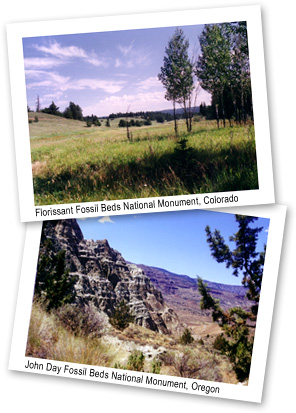
|
|
 |
Fossils in our parklands:
Examples of UCMP service and stewardship
Celebrating the 2016 National Parks centennial
On March 25-27, 2015, UC Berkeley partnered with the National Park Service and the National Geographic Society to mark the anniversary of a conference held in Berkeley 100 years ago that brought together scientists, conservationists, and government officials, leading to the establishment of the National Park Service in 1916. Participants in the three-day summit — called "Science for Parks, Parks for Science: The Next Century" — discussed and advanced the mission of the parks in a changing world. More information, the summit schedule, and a complete list of speakers can be found here. As part of UCMP's participation in the summit, we rededicate this online exhibit, "Fossils in our parklands," with new examples highlighting the importance of fossils in the parks.
The Horace Albright Lecture in Conservation, America's Two Best Ideas — Public Education and Public Lands, was held on March 26 in conjunction with the parks summit.
To date (May 15, 2015), UCMP's collections contain 14,695 fossil specimens from 952 localities in 47 National Park Service parks, monuments, seashores, preserves, scenic rivers, and recreation areas. Learn more about a few of those parks (and some State Parks and other public lands) with fossils represented in the UCMP collections:
The 47 parks with fossils represented in the UCMP collections are listed below by state.
Alaska
Aniakchak National Monument and Preserve
Bering Land Bridge National Preserve
Cape Krusenstern National Monument
Denali National Park and Preserve
Gates of the Arctic National Park and Preserve
Glacier Bay National Park and Preserve
Katmai National Park and Preserve
Kenai Fjords National Park
Kobuk Valley National Park
Lake Clark National Park and Preserve
Noatak National Preserve
Wrangell Saint Elias National Park and Preserve
Arizona
Chiricahua National Monument
Grand Canyon National Park
Petrified Forest National Park
California
Channel Islands National Park
Death Valley National Park
Golden Gate National Recreation Area
Golden Gate National Recreation Area, Thornton State Beach
Lava Beds National Monument
Mojave National Preserve
Point Reyes National Seashore
Santa Monica Mountains National Recreation Area
Whiskeytown-Shasta-Trinity National Recreation Area
Yosemite National Park
Colorado
Florissant Fossil Beds National Monument
Mesa Verde National Park
Florida
Dry Tortugas National Park
Idaho
Hagerman Fossil Beds National Monument
Maine
Acadia National Park
Minnesota
Mississippi National River and Recreation Area
Mississippi National River and Recreation Area, Cherokee Regional Park or Lilydale Regional Park
Mississippi National River and Recreation Area, Minnehaha Regional Park
Mississippi National River and Recreation Area, Shadow Falls Park
Mississippi
Vicksburg National Military Park
Montana
Glacier National Park
Yellowstone National Park
Nebraska
Niobrara National Scenic River
Nevada
Lake Mead National Recreation Area
Tule Springs Fossil Beds National Monument
New Mexico
Pecos National Historical Park
Oregon
John Day Fossil Beds National Monument
South Dakota
Badlands National Park
Texas
Big Bend National Park
Utah
Capitol Reef National Park
Zion National Park
Washington
North Cascades National Park
Olympic National Park
San Juan Island National Historical Park
Wyoming
Bighorn Canyon National Recreation Area
Grand Teton National Park
Yellowstone National Park
Note: Collection of fossil material is illegal unless done under a permit from the National Park Service. If you think you have found a fossil on National Park lands, please contact a park representative.
Florissant and John Day photos by Dave Smith.